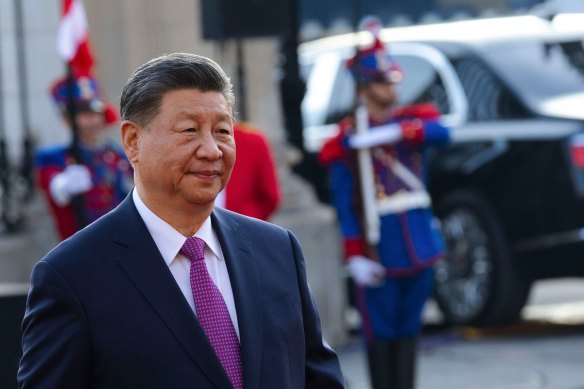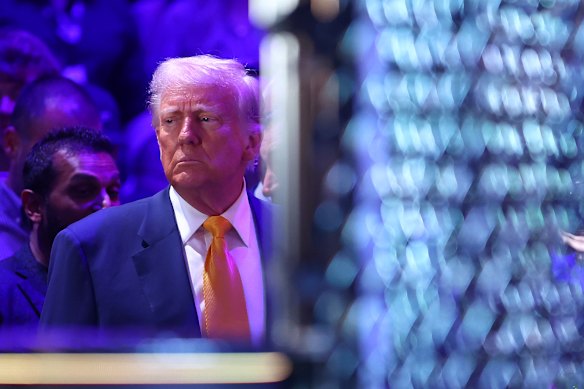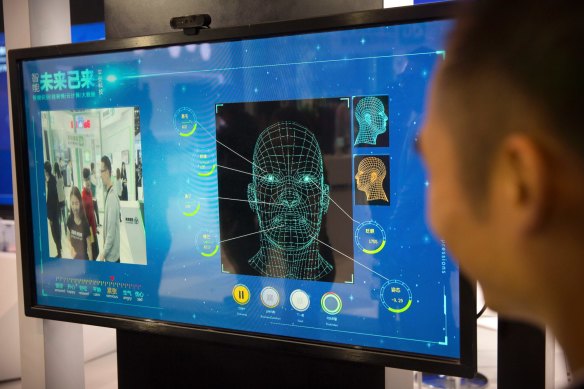Opinion
A China shock 2.0 is emerging to rock America
By Jeremy Warner
They call it “artificial general intelligence” (AGI) and it may be only a matter of a few years away. AGI is the imagined point at which computers finally achieve consciousness, surpass human intelligence and begin to self-improve across virtually all cognitive tasks at an accelerating rate.
Sometimes referred to as the “singularity”, it’s long been the stuff of science fiction, but many techies believe, such is the pace of current development, that it is on the verge of becoming a reality.

Xi Jinping and China’s catch-up and overtake approach to the technologies of the future is already paying big dividends.Credit: Bloomberg
Whoever gets there first, it is widely believed, will inherit the Earth, embedding their influence, ideology and systems of governance into world affairs for generations to come.
It’s a frightening as well as awe-inspiring prospect, and it is one whose potentially transformational geopolitical consequences are only now starting to be more widely appreciated.
And it’s why the US and China are increasingly engaged in what can only be described as a new arms race – or space race – to develop and harness artificial superintelligence for economic and geopolitical superiority. In both jurisdictions, hundreds of billions of dollars a year are being poured into getting there first.
Yet though the Trump administration is only too aware of the threat, its response is oddly backward-looking and counterproductive. Despite the apparent world lead the US has in supercomputing, there is a high chance it will end up losing the war.
In analysing these issues, the US economists David Autor and Gordon Hanson have sounded a long-overdue wake-up call. It will be recalled that these same two economists co-wrote one of the defining papers on what they called the “China shock”, forensically detailing the way sectors and regions exposed to Chinese imports had been hollowed out at a cost of hundreds of thousands of US jobs.
In an article last week for The New York Times, they argue that this process has now largely run its course, but that an even greater threat is emerging – a China shock 2.0 based on the cutting-edge technologies of the so-called fourth industrial revolution.
Yet instead of pursuing the policies needed to meet this threat head-on, the MAGA agenda is heavily focused on fighting the last war – on bringing manufacturing jobs lost to China and elsewhere back to the US.
The challenge, Autor and Hanson argue, is not that of attempting to resuscitate the industrial might of a bygone age, but ensuring that the US is front and centre of the new technologies and able to convincingly harness them to its own ends.

Leading economists say Trump’s White House is not focusing on the right battle with China. Credit: Getty Images
This endeavour is not obviously helped by Trump’s scattergun approach to tariffs, punishing friend and foe alike, his propensity to alienate rather than co-operate with allies, the stupefying attacks on scientific research and the repudiation of foreign talent – once the very lifeblood of American advancement.
Nor is it helped by the administration’s casual disregard for the great asset of dollar hegemony which, bizarrely, Stephen Miran, Trump’s chief economic adviser, seems to regard as in some way partly responsible for America’s de-industrialisation.
An administration seemingly hell-bent on fiscal ruin, and on weakening the dollar for the purposes of making US goods more competitive, doesn’t exactly inspire international confidence in the dollar as a reserve currency asset.
China, by contrast, is investing heavily in the digital yuan as a way of internationalising its own currency, of offering an alternative to the fool’s gold of cryptocurrency and of usurping the dollar for cross-border payments.
Already, it is making steady progress. Why any longer should Brazil use the dollar for selling soybeans to China when Trump threatens the country with punitive tariffs for the sin of prosecuting his friend, Jair Bolsonaro, the former Brazilian president?
Why indeed should it employ the dollar at all when the US regularly uses its power for extraterritorial purposes?
In the developing world, Western influence is waning fast; China has been quick and single-minded at moving into its place.
China has many problems and challenges, from the demographic to the still-deflating credit and property bubbles. But its catch-up and overtake approach to the technologies of the future is already paying big dividends.

China has put itself in position to be the world’s leading science, technology and AI superpower.Credit: AP
As, too, is the aggressive expansion of China’s universities sector, originally begun under Jiang Zemin’s presidency in the late 1990s, and heavily focused on Stem (science, technology, engineering and mathematics) subjects.
According to the Australian Strategic Policy Institute (ASPI), the US-led China in 60 of 64 frontier technologies as recently as 2007, judged by share of the world’s most-cited research, while China led the US in three.
However, by 2023, these rankings were reversed, with China leading in 57 of 64 key technologies, and the US in seven.
“China has built the foundations to position itself as the world’s leading science and technology superpower, by establishing a sometimes stunning lead in high-impact research across the majority of critical and emerging technology domains,” the ASPI says.
All of the world’s top 10 research institutions in some technologies are based in China, and are already collectively generating nine times more high-impact research papers than the second-ranked country (most often the US).
The potential threat from Chinese AI is too great to ignore.
Now, globally recognised companies at the forefront of their industries – such as Huawei in telecommunications, BYD in electric vehicles and Longi in solar wafers – have come from nowhere in less than 30 years to achieve world-leading positions.
Industrial policy in China has, moreover, deliberately targeted key choke points in the supply chain, such that the US was this week forced to abandon its ban on the export of H20 Nvidia chips to China in return for China lifting similar export restrictions on the rare earth minerals vital to many hi-tech industries. The Nvidia ban was completely pointless in any case, serving only to turbocharge Chinese attempts to develop alternatives.
Autor and Hanson suggest that the correct response to the China 2.0 shock is for the US to act in unison with commercial allies such as the EU, Japan, Canada, the UK, Australia and South Korea.
Counter-intuitively, Chinese companies should also be encouraged to set up production facilities in the US and elsewhere, rather similarly to the way that China once enticed Western companies to do the same in China as a way of speeding up technology transfer.
Replicating Chinese industrial policy by aggressively promoting innovation in new fields, as happened in America and Europe during the Second World War, could also help narrow China’s lead.
It scarcely needs saying that Trump’s America is at present doing the opposite of all these things. But just because Trump has got his head buried in the sand doesn’t mean other nations should do the same.
The potential threat from Chinese AI is too great to ignore. If China gets there first, it will reshape the world in its own image, and “the end of history” will look very different from the one outlined by Francis Fukuyama back in 1992, when he declared the final triumph of liberal democracy.
Telegraph, London
The Business Briefing newsletter delivers major stories, exclusive coverage and expert opinion. Sign up to get it every weekday morning.